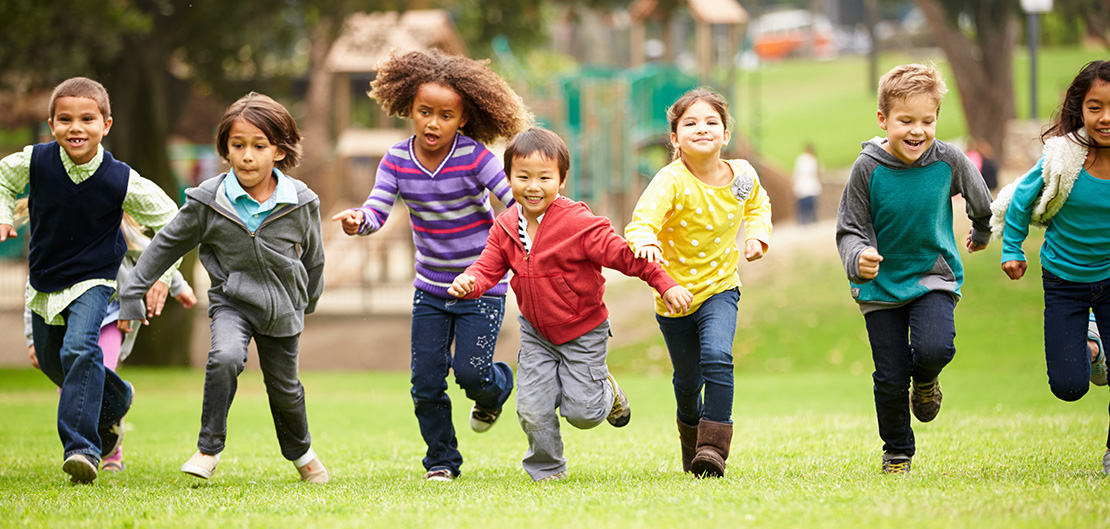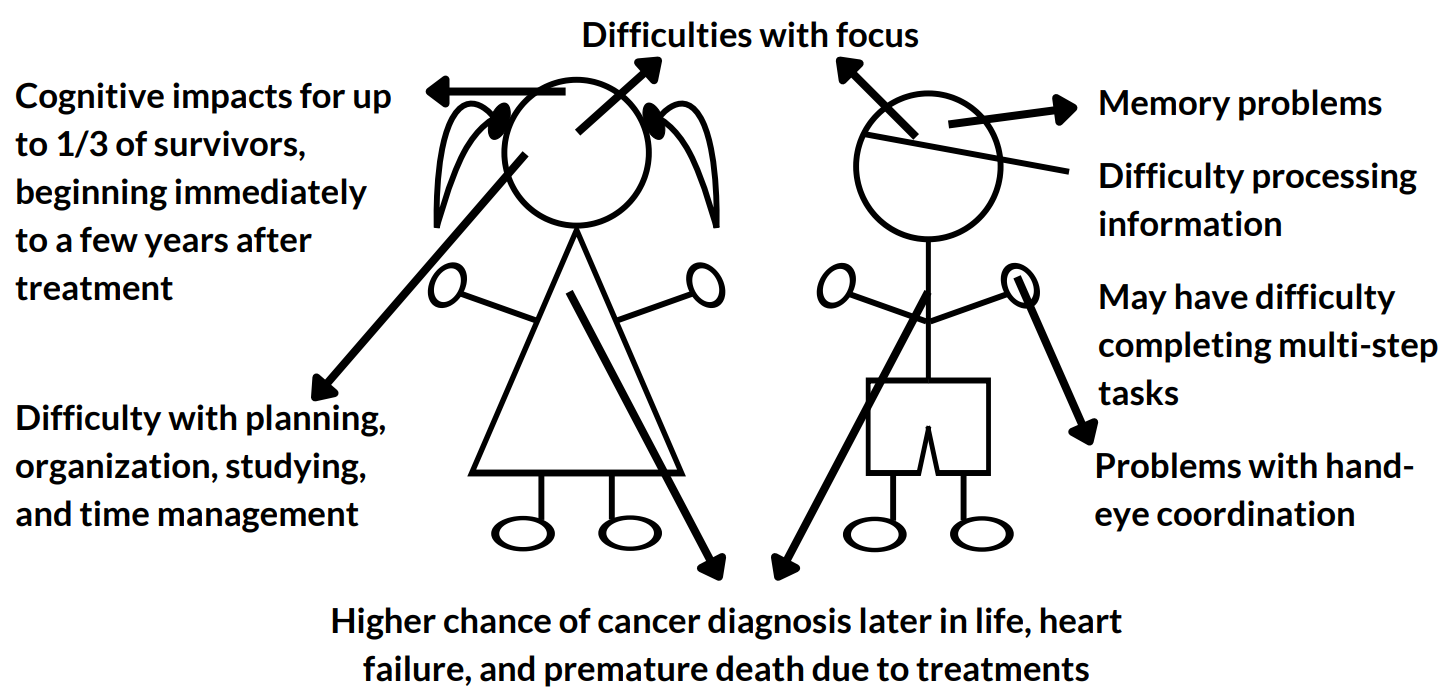Common Physical Challenges

Children and teens may experience physical challenges that are side effects of their treatment and medication related to their cancer diagnosis. These changes could impact how they function throughout the school day including participating in classroom assignments, physical activities, and performing everyday skills.
Children and teens can experience physical and mental tiredness as a result of their cancer treatments and recovery. As a result, they may need to have a rest period, reduced workload, or shortened school day to help them readjust. They may also need help with common school related activities they may be unable to handle on their own.
Questions to consider:
- Does the student need to be exempt from physical activity at recess or during physical education class?
- Do they need extra time to walk to their next class?
- Should they have an extra set of books in the classroom, so they do not have to carry a heavy backpack?
Resources
Fatigue in Children with Cancer provides information related to how to identify and manage cancer-related physical and mental tiredness in children.
Medication and treatment following diagnosis may cause children to experience changes in their appetites. Children and teens may have special eating requirements or may need to eat more meals or snacks during the school day outside of the school’s normal lunch and breakfast schedule.
Resources
Nutritional Needs for Kids With Cancer by Numerous Kids Health provides information on helping children and teens eat well who have been diagnosed with cancer.
A child or teen with treatment-related nervous system damage, known as neuropathy, may have difficulty completing academic tasks. These effects to their nervous system can cause weakness, pain, or tingling in their hands and feet that impact their motor skills like walking up stairs and to classes, playing on the playground, writing notes in class, typing essays, or participating in sports. The discomfort they feel can interfere with their concentration and ability to complete tasks and activities at school.

Resources
View information about how nervous symptoms affect children of different age groups and how to help a child experiencing these symptoms.
Download an Understanding Childhood Cancer By the Numbers flyer.
Download an Understanding The Educational Impacts of Childhood Cancer flyer.
Children and teens can experience mood swings as a result of medications they take in their treatment. These emotions can range from feelings of sadness and irritability, emotional outbursts, changes in temper, and even changes in behavior.
Resources
View tips and information on how to better respond to a child's personality changes as a parent.
Share this BrainPOP video and interactive lesson with kids to teach them about managing conflict at home and discovering positive strategies for coping and communicating how they feel. A free account may be required to access this resource.
Students with a cancer diagnosis may experience changes to their physical appearance and may request dress code accommodations from their school’s administrators that allow them to wear special clothing. This could include wearing hats, scarves, or colored wigs.
Hearing and vision loss can occur during or after treatment for childhood cancer. If it is suspected that a student is having issues in school because of these impairments, it is advised that students be evaluated so that they can receive appropriate support while at school.
Children and teens can often experience nausea and vomiting due to the side effects of medication and treatment. These students may require a late arrival to school. They may need to be monitored throughout the day by their teacher or school nurse if this problem continues throughout the school day.
Pain can be experienced by children and teens as a result of their childhood cancer diagnosis and the treatment they are receiving. A school nurse can administer prescription and nonprescription medication to a student throughout the day with written consent from a parent as well as the child’s doctor in some cases.
Resources
View tips for parents on what is needed for a child’s medication to be administered at school.
Find organizations and support services for children and teens diagnosed with cancer using the Pediatric Cancer Resource Guide from the South Carolina Cancer Alliance.
Find organizations and support services for children and teens diagnosed with cancer using the Pediatric Cancer Resource Guide from the South Carolina Cancer Alliance.
[1] “Fatigue in Children with Cancer.” St. Jude together. Accessed December 1, 2023. https://together.stjude.org/en-us/diagnosis-treatment/side-effects/fatigue.html.
[2] Fullmer, Michell. “Nutritional Needs for Kids With Cancer (for Parents) - Nemours KidsHealth.” Kids Health. Accessed December 1, 2023. https://kidshealth.org/en/parents/cancer-nutrition.html.
[3] Alma, Morgan. “Childhood Cancer Education Toolkit School Section.” ASK Childhood Cancer Foundation. Accessed December 5, 2023. https://www.askccf.org/_files/ugd/44e813_74672b9bfdf64b0d95f339b5cbf2829e.pdf.
[4] “What does chemotherapy-induced peripheral neuropathy (CIPN) look like?.” Children’s Minnesota. Accessed December 15, 2023. https://www.childrensmn.org/services/care-specialties-departments/cancer-blood-disorders/conditions-and-services/cancer-services/chemotherapy-induced-peripheral-neuropathy/#:~:text=What%20does%20chemotherapy%2Dinduced%20peripheral,for%20children%20of%20different%20ages.
[5] “Administering Medication at School: Tips for Parents.” Healthy Children. Last modified December 19, 2016. https://www.healthychildren.org/English/safety-prevention/at-home/medication-safety/Pages/Administering-Medication-at-Child-Care-or-School.aspx.
[6] Solé, Elise. “School allows student with brain cancer to break dress code, wear turquoise wig”. Yahoo!life. Last updated August 27, 2018. https://www.yahoo.com/lifestyle/school-allows-student-brain-cancer-break-dress-code-wear-turquoise-wig-183612851.html?guccounter=1&guce_referrer=aHR0cHM6Ly93d3cuZ29vZ2xlLmNvbS8&guce_referrer_sig=AQAAAMofO8Dn0EWym2U3c38Q8Y0Ats-F1iF5lE2mF3zYy_wpRd84h5p-ZQciKC0m5Yj1EeeMgKuh_wE7e7j3vLcwGyHOIGQlVMNR8gtgnO3130drGoQc3gG6_yPs0o2Wsz9zBzyOWx507g1nvKpDLaBPH8FQ-HI2j6gOeO5RYMIXi4Eu.
[7] Friedman, Les. “Chemotherapy, Kids and Mood Swings.” Mikey’s Way Foundation. Accessed December 28, 2023. https://www.mikeysway.org/chemotherapy-kids-and-mood-swings/#:~:text=But%20are%20you%20prepared%20for,for%20kids%20coping%20with%20cancer.
[8] “Teach kids about conflict resolution at home.” BrainPOP. Accessed January 2, 2024. https://www.brainpop.com/at-home/activities/conflict-resolution?atrkid=V3ADW887B2779_154571225030_kwd-318367781219__663873969589_g_c___&utm_source=google&utm_medium=cpc&utm_term=kids%20conflict%20resolution&utm_content=!acq!v3!154571225030_kwd-318367781219__663873969589_g_c__&utm_campaign=Search+-+Prospecting+-+Generic+-+Conflict+Resolution&gad_source=1&gclid=CjwKCAiAhJWsBhAaEiwAmrNyq_izeQ67VuKpqjfv04OLUdFSoJBjl6VyNnTLtZDk6G8lEtjV3fcdlxoC5EAQAvD_BwE.
[9] “Learning Problems after Treatment.” Children’s Oncology Group. Accessed January 4, 2023. https://www.childrensoncologygroup.org/school-support/learning-problems-after-treatment.